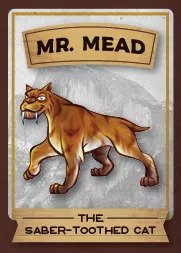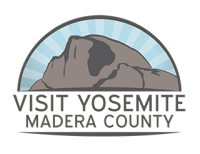MADERA COUNTY — Great news, everyone! You can now collect trading cards from your animal friends at Visit Yosemite Madera County’s Welcoming Committee. These awesome cards can be found at various locations around Madera County.
Mr. Mead the Saber Toothed Cat
MR. MEAD
Saber-toothed cats, also known as saber-toothed tigers or saber-toothed lions, were a group of predatory mammals that lived during the Pleistocene epoch (about 2.5 million to 11,700 years ago). They were characterized by their long, curved canine teeth, which could be up to 7 inches long in some species. The most famous saber-toothed cat is Smilodon, which lived in North and South America during the Pleistocene.
Other saber-toothed cats include Homotherium and Megantereon which lived in the Old World. These cats were apex predators and were likely at the top of the food chain in their respective ecosystems. They went extinct around the end of the last ice age, along with many other large mammals.
Honey the Honey Bee
 You will find HONEY buzzing around the Madera Wine Trail. You can pick up Honey’s trading card in the tasting rooms at these wineries along the Madera Wine Trail:
You will find HONEY buzzing around the Madera Wine Trail. You can pick up Honey’s trading card in the tasting rooms at these wineries along the Madera Wine Trail:
Fasi Estate Winery – 42415 Road 208 (off Highway 41), Friant.
Ficklin Vineyards – 30246 Avenue 7 1/2, Madera.
Quady Winery – 13181 Road 24, Madera.
Westbrook Wine Farm Vineyard and Winery – (reservation required; call 559-868-3499) – 49610 House Ranch Road, O’Neals.
Idle Hour Winery and Queen’s Inn Wine Bar & Beer Garden – 41139 Highway 41, Oakhurst.
San Joaquin Wine Company – 21821 Avenue 16, Madera.
Papagni Wines – 9505 Road 30 1/2, Madera.
Toca Madera Winery – 36140 Avenue 9, Madera.
Birdstone Winery – 9400 Road 34, Madera.
Apis Mellifera is the scientific name for the European honey bee. It is a species of honey bee that is native to Europe, Asia, and Africa, but has been introduced to many other parts of the world. Honey bees are social insects that live in colonies, which can contain thousands of individuals. They are known for their ability to produce and store honey, as well as for their role in pollination.
Honey bees have a complex social structure and division of labor, with specialized roles for workers, drones, and a queen bee. They communicate with one another using a variety of behaviors, including dancing, to convey information about food sources and other important information.
Nugget the California Ebony Tarantula
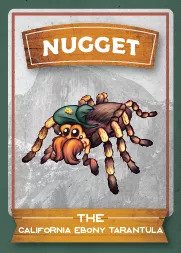
- Zanders Coffee
- Industrial Gypsy Rock Shop
- Wild Fig Kitchen
- Yosemite Drug
- Yours, Mine & Ours Antiques
The village is located on the corner of Highway 41 and Road 415 at
The California Ebony Tarantula, also known as Aphonopelma eutylenum, is a species of tarantula native to California and parts of Nevada. They are a burrowing species and can be found in a variety of habitats, including deserts, chaparral, and oak woodlands.
They are usually black or dark brown in color, with females reaching a leg span of up to four inches and males up to three inches. They are typically docile and make a good choice for beginners in tarantula keeping. The lifespan of the California Ebony Tarantula is around 15-20 years.
Sierra the Black Bear
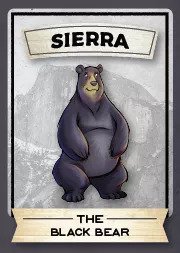
The black bear (Ursus americanus) is a medium-sized mammal found in North America, including Canada, the United States and Mexico. They have shaggy, black fur and a distinctive hump on their shoulders. They are omnivores and their diet can include a variety of plant and animal matter, such as berries, fruits, insects, fish, and small mammals.
Black bears are typically solitary animals, but may come together in small groups during mating season or when food is plentiful. They can live in a variety of habitats, including forests, mountains, and swamps. Black bears are generally not considered dangerous to humans, but should still be respected and avoided in the wild.
Art E. Fox the Sierra Nevada Red Fox
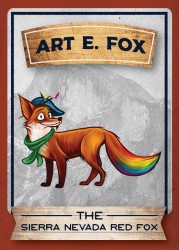 You can find ART E. FOX at the many galleries of the Yosemite Gateway Art Center in Oakhurst.
You can find ART E. FOX at the many galleries of the Yosemite Gateway Art Center in Oakhurst.
He’ll be hanging out with all the wonderful artists in the area.
The Art Center and galleries are located at 40982 Highway 41, Oakhurst.
The Sierra Nevada red fox (Vulpes vulpes necator) is a subspecies of the red fox that is native to the Sierra Nevada mountain range in California, USA. It is a small, carnivorous mammal with a distinctive rusty red coat, white underbelly, and a bushy tail with a white tip.
The Sierra Nevada red fox is considered an alpine specialist, living at elevations above 6,000 feet. They are generally solitary and nocturnal, living in dens they dig in the ground or in rocky crevices. They eat a variety of small mammals, birds, insects, berries and other fruits. The Sierra Nevada red fox is considered a threatened species due to habitat loss and fragmentation, as well as hunting and trapping.
BLake the Bald Eagle
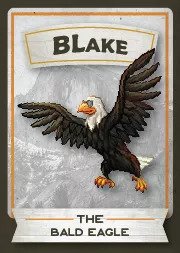
The Forks Resort – at the Registration Desk (open seasonally April through September) CLOSED FOR THE SEASON UNTIL MARCH 22nd 2022
Miller’s Landing Resort – at the Registration Desk (open seasonally April through September) CLOSED FOR THE SEASON UNTIL MARCH 22nd 2022
The Pines Resort – at the Registration Desk
The Bald Eagle (Haliaeetus leucocephalus) is a bird of prey found in North America. It is the national bird of the United States and appears on its national seal. Bald Eagles are large birds, with a wingspan of up to 2.5 meters (8.2 feet) and weighing up to 4.5 kg (9.9 pounds). They are dark brown with a white head and tail, and have a hooked beak and sharp talons. They feed mainly on fish, but will also eat small mammals, birds, and carrion.
Bald Eagles are apex predators and are not preyed upon by any other animals. They are not truly bald, the name derives from an older meaning of “white headed.” Bald Eagles were once endangered, but their population has recovered due to conservation efforts.
Ricky the Raccoon

When the Railroad is closed for the season, you can ask for your Ricky at the Visitor Center in Oakhurst.
Raccoons are medium-sized mammals native to North America. They have distinctive black and white markings on their face, and their fur is typically grayish-brown. Raccoons are omnivores and opportunistic feeders, meaning they will eat a wide variety of foods, including fruits, berries, insects, fish, and small mammals. They are also known to raid gardens and trash cans in search of food.
Raccoons are nocturnal animals, meaning they are active at night and sleep during the day. They are also known to be very curious and intelligent animals. They can carry some zoonotic diseases such as Rabies, so it’s best not to approach them if you see them in the wild.
Ranger the California Mule Deer
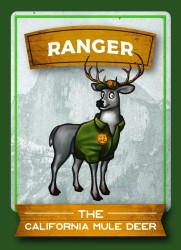 RANGER can be found at these North Fork locations:
RANGER can be found at these North Fork locations:
The California mule deer (Odocoileus hemionus californicus) is a subspecies of the mule deer (Odocoileus hemionus) that is native to the western United States, specifically California. They have large ears that resemble those of a mule, which is where they get their name. They are generally brown in color with white underbellies and have large, multi-pointed antlers.
Mule deer are known for their agility and speed and are able to jump great distances and heights. They are herbivores and their diet primarily consists of grasses, forbs, and shrubs. They are active during the day and are typically found in mountainous regions, but can also be found in foothills and even some coastal regions.
Galen the Great Horned Owl
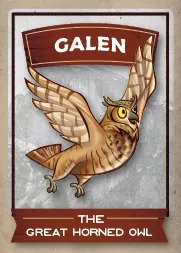
The Great Horned Owl (Bubo virginianus) is a large owl native to the Americas. It is also known as the “hoot owl” for its distinctive call. They are found in a wide range of habitats including forests, deserts, and grasslands. They have a large, broad head with prominent ear tufts (hence the name “horned owl”), and yellow eyes.
Great horned owls are generally brown or gray in color with white or light-colored underparts. They are apex predators and feed on a wide variety of prey including small mammals, birds, reptiles, and insects. They are also known for their fierce territorial behavior, and will defend their nest sites against other animals.
Sandy the Squirrel

Squirrels are a group of small to medium-sized rodents of the family Sciuridae. The species Sciurus griseus, also known as the grey squirrel, is a tree squirrel that is native to the eastern and central United States, but has been introduced to other parts of the world, such as the United Kingdom.
Grey squirrels are larger than red squirrels and have a thick, bushy tail. They are typically grey in color, but can also be black or brown. They are omnivorous, eating a variety of foods such as nuts, seeds, fruits, and insects. They are known for their agility and ability to climb trees and are also opportunistic scavengers.



